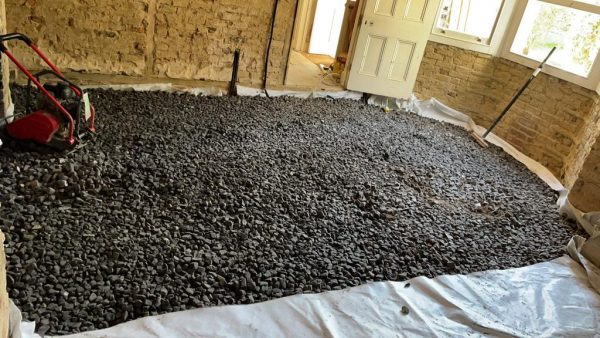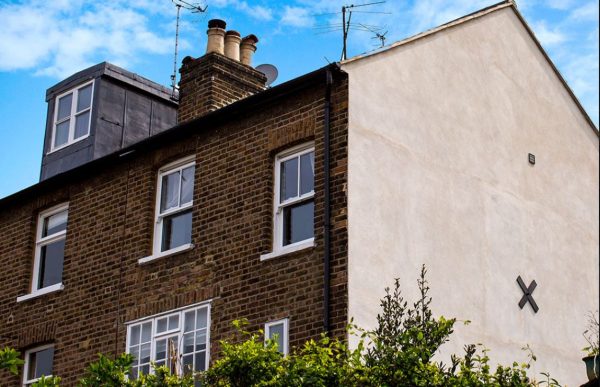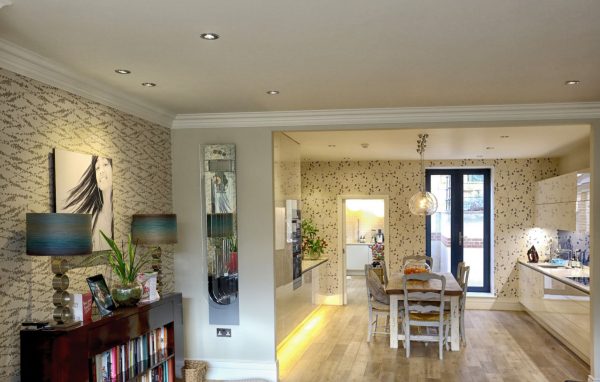How to turn your house into an eco-friendly home

Sustainable retro-fitted eco-friendly homes are designed and built with the aim of having as low an impact on the living environment as possible.
The non-standard home insurance team at Adrian Flux spoke to the London Building Renovation company, who are specialists in restoration and heritage work throughout London and the home counties.
Owner Kevin Nind outlined some of his favourite products that can help you create a truly eco-friendly home. But first, what’s needed to make your house an eco-friendly home?
All pictures courtesy of the London Building Renovation company.
How do I create an eco-friendly home?
If you aim to live in an eco-friendly home, you will need to maximise the building’s performance. That means:
Reusing as many materials as possible and avoiding waste. For example, if you are demolishing part of your home, save the bricks, clean them and re-use them in your renovations
Using as few environmental toxins as possible (for example, using paints with low volatile organic compounds)
Including features that will ensure optimum energy efficiency, all through the home, right around the year
Making the best use of naturally occurring sources of heat and light – they are free!
Here are some of the eco-friendly building materials that Kevin and the London Building Renovation company likes to use.
1. Recycled compressed glass flooring
It doesn’t come much more sustainable than constructing the floors in your eco-friendly home with recycled glass. It’s actually made from recycled car windscreens and is supplied by Mike Wye,, a traditional uilding and decorating specialist.
The glass comes in barbecue briquette-sized chunks and is ground down on site to a uniform size and then wrapped in a permeable membrane. It is then tamped and compressed and a lime screed is applied.
This is preferable to the alternative, concrete slabs laid over compacted hardcore.

The glass briquettes are crushed and tamped level before a lime screed is added.
2. Eco-friendly construction materials
You need to choose the construction materials in your retro-fit eco-friendly home with care. Choose from the following.
Cob blocks
Cob blocks are traditional structural building blocks made from a mixture of subsoil, aggregates and straw. They are ideal for either restoring traditional cob walls in need of repair or building the perfect eco-home from the ground up.
Lime render
Lime render is the first coat of lime plaster applied to the external surfaces of traditionally-built stone or brick buildings. It allows the building to “breathe”; as lime is porous, this means it allows moisture to collect and evaporate.
Portland cement, on the other hand, which is often used as render on stone or brick buildings, traps moisture behind the stonework, which can result in the erosion of the masonry.
Once applied, the lime render is usually coated with a lime wash.
The manufacturing of lime produces CO2, but after a lime product has been installed it begins to cure. During the curing process, the lime carbonates – taking CO2 back out of the air around it.
Reclaimed bricks
Reclaimed stock bricks are beautiful, especially when used on a period property. They have an instant aesthetic effect by adding charm, warmth and familiarity, all of which you don’t get from new bricks.
Reclaimed bricks also help your current home blend in perfectly with the extension or other renovation works you are doing.
Using this material is also better for the environment. Read our blog to find out how you can extend and blend with reclaimed stock bricks.
Hempcrete
Hempcrete is made from natural materials, lime and hemp. The lime component consists of air lime that is formulated to speed up the setting process.
Hemp is a plant that can be grown without using chemicals, requires little water and contributes to agricultural soil regeneration.
The combination of lime and hemp creates a natural, lightweight concrete. Its thermal mass and permeability make it the ultimate green building material for your eco-friendly home.
It can be used to build, renovate and restore all types of home, from houses and apartment blocks to traditional buildings and listed historic buildings.
It is incredibly versatile, and can be used to construct insulating walls, linings, roofs, screeds, attic spaces and renders.
However, hempcrete is not a load-bearing material. It is cast around a primary or secondary structural frame made of timber, metal or concrete. It is also used to replace deteriorated cob in half-timbered walls. As an insulating lining, it can be cast on all standard mineral substrates.
Lime mortar in brickwork
Lime mortar is a natural product used in period properties. It allows movement and breathability within the building and therefore helps prevent the occurrence and build up of damp. As well as being green and practical, many feel it looks more attractive than traditional sand and cement.

3. Alternative insulation in an eco-friendly home
There are a number of different types of eco-friendly insulation you can choose for your retro-fit home. These include the following.
Cork lining
Cork provides excellent insulation both for heat preservation and to keep any noise out. The cork is bonded to the walls with an environmentally friendly lime-based adhesive.
Cork is also a breathable material, meaning it prevents damp from becoming trapped in the building’s walls. Read our blog to find out why damp can be a big problem in your period home.
Wood fibreboard insulation
Recycled wood is cut and chipped into small pieces, which are washed to remove impurities and metal scraps such as nails. The chips are then steamed to soften them for defibration. Paraffin wax is added to the steamed chips and they are transformed into fluffy fibres in a defibrator. Soon afterwards, they are sprayed with adhesives.
Fibres or chips are arranged into a uniform “mat” on a conveyor belt. The mat is pre-compressed and then hot-pressed. Hot-pressing activates the adhesive and glues the fibres or chips together. Board is then cooled, trimmed, sanded and maybe veneered or laminated.
Wood fibreboards store more CO2 within them than what is produced when they are being manufactured, making them carbon negative. Fibreboard can be used in:
sound proofing/deadening
structural sheathing
low-slope roofing
sound deadening flooring underlay
4. Windows
A huge amount of heat is lost through windows so, wherever possible, it’s recommended that you use triple glazing or – if you live in a listed building – secondary glazing.
Select sustainable wooden frames or frames manufactured from recycled aluminium.
5. Eco-friendly power sources and heating
There are many ways you can choose to heat and generate hot water in your home while retaining the building’s sustainable qualities.
Solar or wind power
Make use of mother nature’s free natural resources by harnessing solar power or wind power to generate electricity. It could not only save you money, but make you money too, as the power you generate that exceeds your needs can be sold back to the National Grid. Read our blog to find out how much money you can save by fitting solar panels on your home.
Thermodynamic panels
Still relatively new, thermodynamic panels are remarkably efficient and reliable. Unlike solar panels, they work day and night and can generate power during rain and snowfall.
Ground source heat pumps
A ground source heat pump transfers heat from the ground, taking advantage of the relative constancy of temperatures of the earth through the seasons. They are among the most energy-efficient technologies for providing heating, ventilation, air conditioning and water heating, using far less energy than can be achieved by burning fuel or electric heaters.
Air source heat pumps
An air source heat pump absorbs heat from outside a building and releases it inside using the same vapour-compression refrigeration process and much the same equipment as an air conditioner – except it’s used in the opposite direction.
Unlike an air conditioning unit, most air source heat pumps are reversible and are able to either warm or cool buildings and in some cases also provide hot water.
Mechanical Ventilation with Heat Recovery
Mechanical Ventilation with Heat Recovery (MVHR) provides fresh filtered air into a building whilst retaining most of the energy that has already been used in heating the building.
Battery
A battery power system will take energy created by a fuel generation system and store what is not used until it is needed, ensuring no energy is wasted.

6. Green roofing
A green roof or living roof is a roof partially or completely covered with vegetation and a growing medium, planted over a waterproofing membrane. It may include additional layers, such as a root barrier and drainage and irrigation systems.
The roof garden is the most beautiful way of increasing the sustainability of your eco-friendly home.
Consider the costs and life expectancy of the materials
Kevin provided the following tips to make your home as eco-friendly as possible: “Whatever products you choose in your eco-friendly retro-fit home, you should consider their [upfront] cost, their running costs, their life expectancy and the likely cost of replacement down the line.
“One thing you could do immediately and at negligible cost to improve the efficiency of your home is to plug all the drafts. It might be as simple as a curtain over a door or some tape over a keyhole, but it can make a huge difference to heating and power consumption in your home.
“And remember: if you live in a listed building you cannot do any of these things without first taking advice from your local building authority and a specialist architect.”
Insurance for your eco-friendly home
While most people have a desire to lower their carbon footprint by driving a greener car or living in an eco-friendly home, they may not realise that the changes they make in their home may affect their insurance. It is very likely that many standard insurers would be unable to quote you to cover an eco-friendly home.
That’s why you need to go with a specialist insurance company with expertise in providing non-standard eco-home insurance. Call Adrian Flux on 0800 369 8590 for a fast, no-hassle quote – 81.5% of all customers receiving an online quote in [[ FLUX_AVG_SAVING_DISCLAIMER_MONTH ]] could have obtained a cheaper quote over the phone, based on the information they provided.. Alternatively, book a callback at a time that suits you.
Adrian Flux are doing their bit to help the environment too. We don’t waste valuable resources with unnecessary paper quotes and files – all policy certificates and documentation are available digitally.






